FEATURES|THEMES|Philosophy and Buddhist Studies
Buddhism in Siberia: Aginsky Buddhist Academy
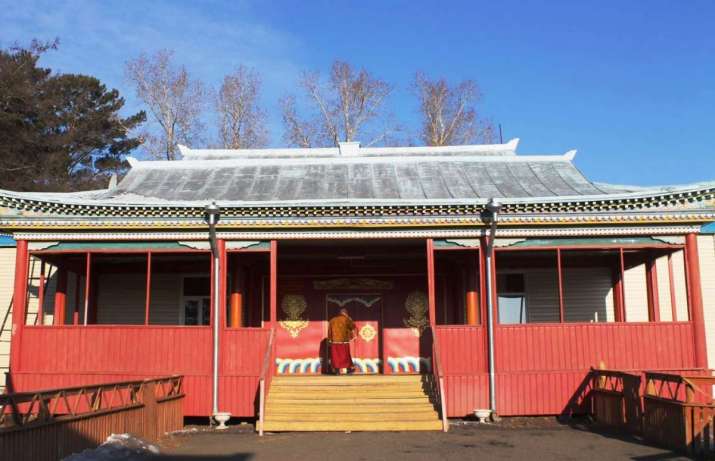 Aginsky Buddhsit Academy. From нерчинск.забайкальскийкрай.рф
Aginsky Buddhsit Academy. From нерчинск.забайкальскийкрай.рфAginsky Buddhist Academy is a spiritual professional educational institution located in the village of Amithasha, in Agin-Buryat District of Transbaikal Territory (Zabaykalye), in southeastern Siberia. The academy is part of the temple complex of Aginsky Datsan Dechen Lhundubling (Tib: Dechen Lhundrup Ling; “Abode of the Spontaneous Realization of Great Bliss”), one of the leading centers of Buddhist education in Russia.
Aginsky Datsan is one of the oldest Buddhist monasteries in Siberia, dating to the early 19th century. It was founded in 1811 and consecrated in 1816 by Lama Rinchen. By that time, Buddhism, mostly in the form of the Tibetan Gelug tradition, had spread across Buryatia, the Siberian republic bordering Zabaykalye. At the beginning of the 17th century, Buddhism spread north from Mongolia to Buryatia, and in 1741 it was officially accepted in Russia when one of the country’s most popular monarchs, Empress Elisabeth Petrovna (r. 1741–62), recognized the Buddhist tradition in Buryatia.
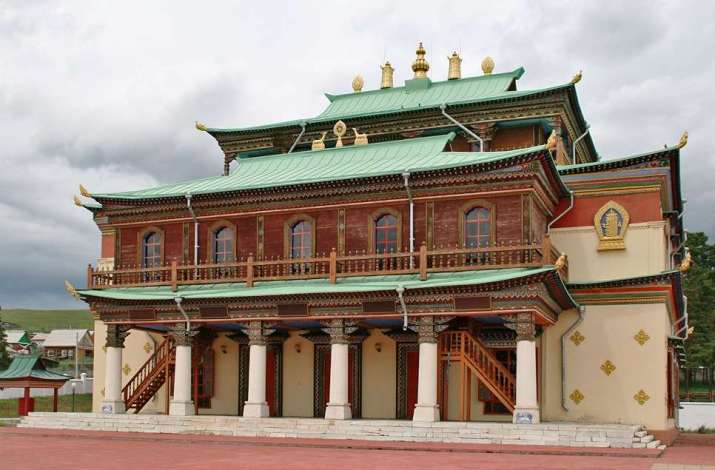 Aginsky Datsan. From veternity.livejournal.com
Aginsky Datsan. From veternity.livejournal.com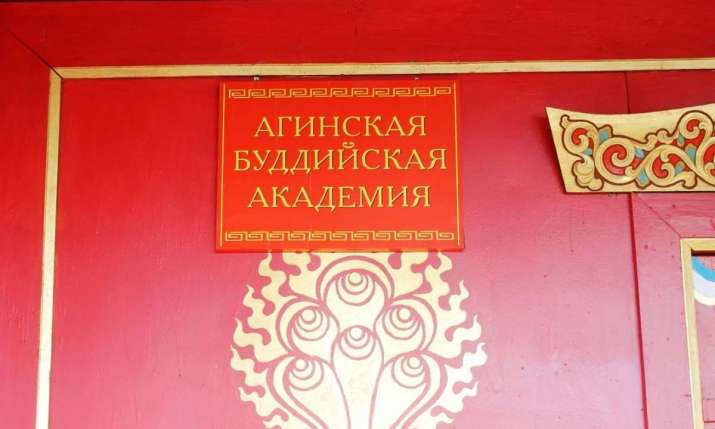 The name of the Academy written in Russian. From нерчинск.забайкальскийкрай.рф
The name of the Academy written in Russian. From нерчинск.забайкальскийкрай.рфThe schools of philosophy, tantra, medicine, and astrology opened in Aginsky Datsan in 1861. The popular printing house of the datsan kept 47,525 xylographic boards with Tibetan and Mongolian texts, as well as wooden plates with drawings. The datsan published many books on Buddhist philosophy, medicine, astronomy, astrology, Tibetan language, and popular didactic literature, dictionaries, and so on.
During the anti-religious campaign of the 1930s, almost all of the Buddhist temples in the country were closed and many lamas were arrested. The campaign began in 1929 by the All-Union Communist Party (Bolsheviks) with the drafting of new legislation that severely prohibited religious activities and called for an education process on religion in order to further disseminate atheism and materialist philosophy. Aginsky Datsan was partially destroyed and the only reason it was spared complete destruction by the communists was because its buildings were repurposed as a tuberculosis sanatorium. In 1946, Aginsky Datsan, along with Ivolginsky Datsan in Buryatia, reopened for political reasons, aimed at showing that there was freedom of religion in the USSR. However, the authorities closely monitored all religious activities.*
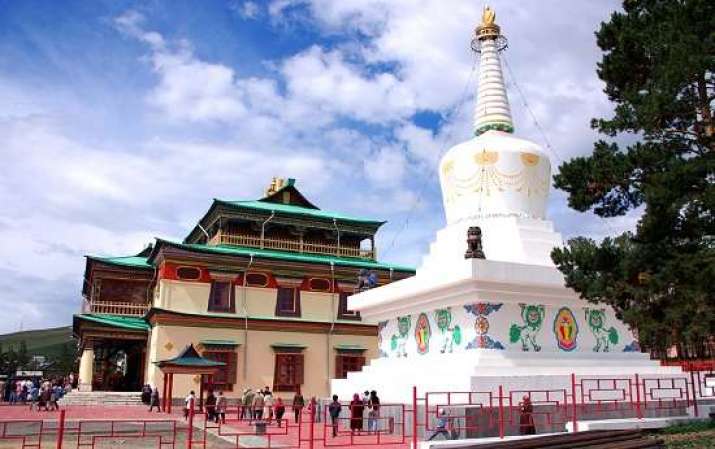 Aginsky Datsan with stupa. From o-buddizme.ru
Aginsky Datsan with stupa. From o-buddizme.ruThe true revival of Buddhism in Russia began in the 1990s. In 1991, His Holiness the Dalai Lama visited the former Aginsk-Buryat Autonomous District (now Agin-Buryat District of Zabaykalye). Two years later, the foundations of Aginsky Buddhist Academy were laid at the initiative of Babu Lama (Vladimir Chimitdorjiev, 1956-2011), who became the first rector.
In 1993, by a decision of the Small Council of the Aginsky District Executive Committee, the School of Tibetan Medicine was opened, continuing the educational traditions of Aginsky Datsan. In September of the same year, the first 56 students were admitted in two fields of study: Tibetan medicine and Buddhist philosophy. The students of the Faculty of Tibetan Medicine were taught by a specialist from Inner Mongolia, Dashitsirene Zhambal, while Geshe Dhonam from Goman Monastery in southern India taught Buddhist philosophy. In 1994, the School of Tibetan Medicine was recognized as a branch of the Tibetan Medical and Astrological Institute or Men-Tsee Khang in Dharamsala, India. In 1998, the status of Aginsky Buryat Buddhist Institute was formalized with a federal license from the Ministry of General and Professional Education of the Russian Federation for the right to conduct educational activities in the field of higher religious education in the direction of Buddhist sciences (Buddhist philosophy and Tibetan medicine).
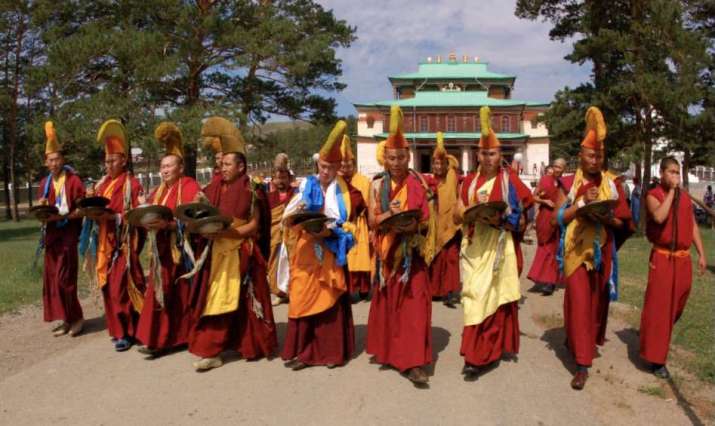 Religious ceremony at Aginsky Datsan. From aginskydatsan.ru
Religious ceremony at Aginsky Datsan. From aginskydatsan.ruIn 2003, Aginsky Buryat Buddhist Institute received the status of Aginsky Buddhist Academy, with 25 teachers, five doctors of Buddhist philosophy, five masters of Buddhist science, and so on. Since the 2012–13 academic year, students of the academy annually undergo training at the medical clinic of Chinese-Mongolian traditional medicine in Manchuria—large overlapping historical and geographic regions of Russia and China.
The academical aim of Aginsky Buddhist Academy is to integrate spiritual and secular education and to find a synthesis of knowledge in Western and Eastern medical practices. The academy carries out educational activities on the basis of license No. 000589, issued by the Federal Service for Supervision in Education and Science—a Russian agency overseeing national education and science. The institution now consists of faculties of philosophy, astrology, astronomy, Buddhist arts, and Tibetan medicine. Education lasts four years, after which the students receive diplomas in the specialties of instructor-researcher of Tibetan medicine, philosopher-theologian, and master of Buddhist painting. They are awarded a Bachelor degree in Buddhist Science. The monks and lamas of Aginsky Buddhist Academy were famous for their scholarship far beyond the borders of Russia, and the level of their knowledge has been compared with that of the leading Buddhist teachers of Tibet and Mongolia.
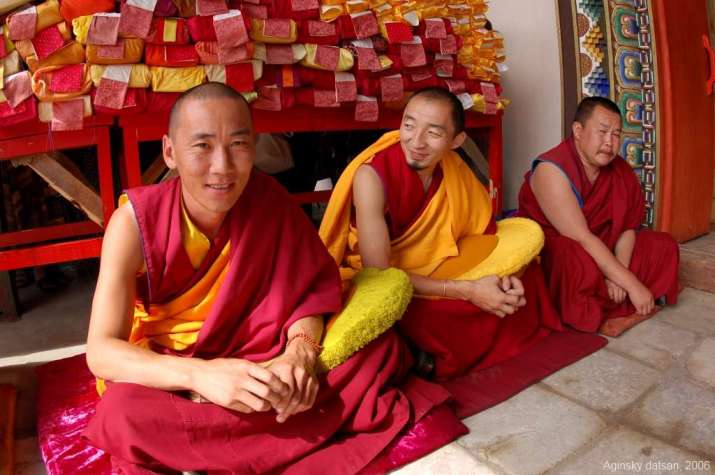 Monks at Aginsky Datsan. From aginskydatsan.ru
Monks at Aginsky Datsan. From aginskydatsan.ru* Buddhism in Russia: History and Modernity (Buddhistdoor Global)
See more
Aginsky Datsan
Агинский дацан в Забайкальском крае — крупный буддийский центр в России
Aginsky datsan: The house of ringing bells
Related features from Buddhistdoor Global
Buddhism in Buryatia: Datsan Rinpoche Bagsha
Buddhism in Buryatia: The Palace of Vajrasattva Buddha
The Path of the First Acharya in Russia: An Interview with Bem Mitruev, Part 1














